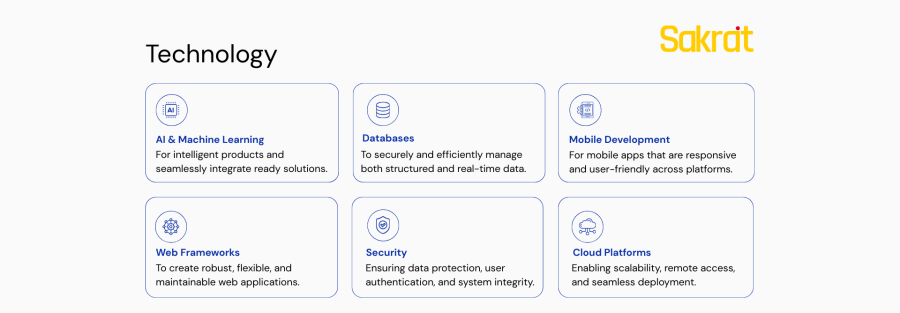Top 5 Mobile App Development Trends for 2026
The world of mobile app development is in a constant state of evolution, but the pace of change heading into 2026 is unprecedented. The technologies that were once considered experimental like AI and AR are now becoming foundational pillars of modern app experiences.
For businesses, simply having a mobile app is no longer enough. To capture and retain user attention in a crowded marketplace, you must build applications that are intelligent, immersive, and seamlessly integrated into your users’ lives. Here are the five most important trends that will define mobile app development in 2026.
1. AI-First App Architectures
For years, AI has been a “feature” added to an app. By 2026, this will be inverted: successful apps will be built on an AI-first architecture, where artificial intelligence is the core foundation, not an afterthought. This means designing the entire application around AI’s ability to create hyper-personalized and predictive experiences.
- What it looks like: Instead of a static interface, an AI-first app dynamically adapts its content, layout, and recommendations in real time based on user behaviour. It anticipates user needs before they are even expressed.
- Business Impact: This shift is moving beyond simple recommendation engines. It’s about using on-device AI to automate complex tasks, generate personalized content, and enhance security with advanced biometric authentication all while keeping user data secure on their device.
2. Cross-Platform Development 3.0
The long-standing debate between native and hybrid development is becoming irrelevant. The next generation of cross-platform tools like Flutter, React Native, and Kotlin Multiplatform has matured to the point where they can deliver near-native performance from a single codebase.
- What’s new: This isn’t just about mobile anymore. “Cross-Platform 3.0” is about creating a unified experience across a vast ecosystem of devices like phones, tablets, desktops, wearables, TVs, and even cars all from one shared code repository.
- Business Impact: The speed-to-market and cost-efficiency advantages are massive. Companies that master a single-codebase strategy can deploy new features and updates across all user touchpoints simultaneously, gaining a significant competitive edge over those still managing separate native development teams.
3. Practical Augmented Reality (AR) and Mixed Reality
Augmented Reality is finally moving beyond gaming gimmicks and finding real, practical use cases in everyday apps. As hardware like Apple’s Vision Pro becomes more accessible and mobile devices gain more powerful graphics support, AR is set to become a key differentiator in a wide range of industries.
- What it looks like:
- Retail: Virtual “try-on” features for clothes and furniture.
- Healthcare: Immersive surgical training simulations.
- Education: Interactive 3D learning models that bring complex subjects to life.
- Real Estate: Virtual property tours that can be experienced from anywhere.
- Business Impact: AR creates a stickier, more engaging user experience that can directly drive sales and improve learning outcomes. By 2026, integrating AR features will move from a “nice-to-have” to a competitive necessity in many sectors.
4. Hyper-Connectivity Fuelled by 5G and IoT
The widespread adoption of 5G is the critical enabler for many of these advanced app experiences. With speeds up to 100 times faster than 4G and a 10x decrease in latency, 5G eliminates the performance bottlenecks that previously limited app functionality.
- What it looks like: This hyper-connectivity is the backbone of the Internet of Things (IoT), allowing your mobile app to become the central command center for a network of connected devices from smart home appliances to wearable health trackers. The global IoT market is expected to reach nearly $1.4 trillion by the end of 2025, with mobile apps at the heart of this growth.
- Business Impact: 5G and IoT integration allows for the development of more sophisticated apps that require real-time data processing, such as seamless high-definition video streaming, competitive online gaming, and real-time monitoring in logistics and manufacturing.
5. Inclusive and Accessible Design as a Core Requirement
Designing for accessibility is no longer an optional extra; it’s a legal and ethical imperative that also happens to be a huge business opportunity. With over 1.3 billion people worldwide living with some form of disability, building inclusive apps is essential for reaching the widest possible audience.
- What it looks like: This goes beyond compliance with regulations like the ADA in the U.S. and EN 301 549 in Europe. It means integrating features like scalable text, high-contrast modes, and seamless voice control from the ground up.
- Business Impact: Adopting “privacy-by-design” and “accessibility-by-design” principles leads to cleaner, more intuitive user interfaces that benefit all users, not just those with disabilities. It builds trust, expands your market, and results in a better product for everyone.
Conclusion: The Future is Intelligent, Immersive, and Integrated
The common thread weaving through all these trends is a move toward more intelligent, context-aware, and seamlessly integrated experiences. The future of mobile is not about standalone apps but about creating fluid ecosystems that connect users to their world in more meaningful ways. Businesses that embrace this vision by building with AI at the core, designing for a multi-device reality, and leveraging next-generation connectivity will be the ones that capture user loyalty and lead their industries in 2026 and beyond.
Is Your Mobile App Ready for 2026?
The future of mobile is arriving faster than ever. Don’t let your application fall behind.
Ready to future-proof your mobile strategy? Contact our team of experts today for a free consultation. We can help you identify which of these trends will have the biggest impact on your business and build a roadmap to turn your vision into a reality.


